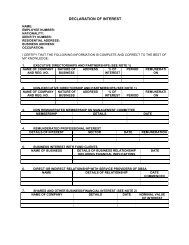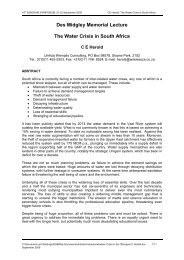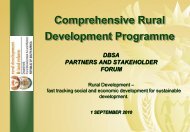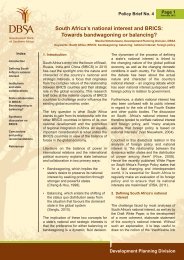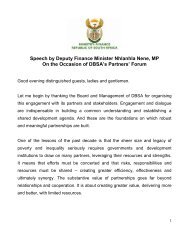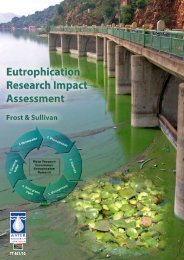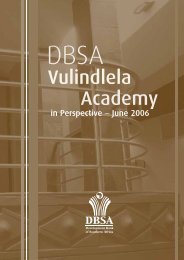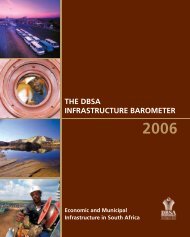ANNUAL REPORTS
ANNUAL REPORTS
ANNUAL REPORTS
Create successful ePaper yourself
Turn your PDF publications into a flip-book with our unique Google optimized e-Paper software.
Chief Executive Officer’s report<br />
I am pleased to report that the DBSA has once again<br />
exceeded most of its developmental and operational targets<br />
for the year, with record investment approvals of R37,1 billion<br />
in 2010/11. This is even more impressive considering that<br />
conditions in the Bank’s mandate space made meeting<br />
ambitious performance targets a challenge. In South Africa,<br />
these challenges included a hesitant and uneven economic<br />
recovery, which affected the income of many public and<br />
private sector entities; structurally weak finances in many<br />
municipalities; the low level of interest rates, which affected<br />
the Bank’s interest income from investments; and institutional<br />
capacity challenges in government, which limited its ability<br />
to accelerate infrastructure project delivery and thus take<br />
up developmental loans. As a result, a proportion of capital<br />
requirements remains unfunded.<br />
Real economic growth<br />
% change<br />
Municipal infrastructure funding gap, 2009 to 2011<br />
R billion<br />
8<br />
7<br />
6<br />
5<br />
4<br />
3<br />
2<br />
1<br />
0<br />
-1<br />
-2<br />
300<br />
250<br />
200<br />
150<br />
100<br />
50<br />
2004 2005 2006 2007 2008 2009 2010<br />
South Africa GDP % change Sub-Saharan Africa GDP % change<br />
Source: South African Reserve Bank and IMF, June 2011<br />
0<br />
2009/10 2010/11 2011/12<br />
Conditional grants Own revenue Planned borrowing Unfunded gap<br />
Sources: Division of Revenue Act, 2011; National Budget Review, National Treasury,<br />
2011; Municipal Infrastructure Investment Framework 7, 2011<br />
The Bank makes a considerable non-funding effort in the<br />
areas of research, capacity building and assistance with<br />
programme development and project management. Much of<br />
this is directly or indirectly geared to building the institutional<br />
capacity of government to plan and deliver infrastructure<br />
projects and improve the delivery of services to communities.<br />
On a regional level, improved economic performance by<br />
many SADC countries in the year under review and the<br />
re-emergence of positive regional fundamentals after a<br />
difficult 2009/10 improved the climate for the Bank’s regional<br />
investment activities. Improved liquidity in global financial<br />
markets also made for better access to capital markets,<br />
although there were more competitive issuance dynamics in<br />
the primary capital markets.<br />
However, the Bank’s favourable performance over the past<br />
year must be seen in context. The developmental needs<br />
in South Africa and the region are massive. The outbreak<br />
of violence in some parts of the continent, including labour<br />
agitation in South Africa, is an expression of the pent-up<br />
demand for services. Economic growth and job creation,<br />
as well as the eradication of backlogs in household<br />
service provision, lie at the heart of reducing poverty and<br />
inequality and improving the quality of life of the people<br />
of South Africa and the region. Meeting these challenges<br />
has become imperative and urgent, and government is<br />
conscious of the risk posed by poor delivery and lethargic<br />
bureaucracy and their impact on continued political stability.<br />
The government’s plan to spend R800 billion on infrastructure<br />
over the next five years has been on the table for some time.<br />
This has now increased to well over a trillion rand, owing<br />
to escalations and the formulation of additional plans for<br />
transport, roads and so forth. However, during the year<br />
much of government’s focus, and by extension that of the<br />
DBSA, has remained on the difficult task of translating<br />
agreements on National Priorities into key initiatives within<br />
sector departments, with a view to increased, visible delivery<br />
on commitments across the country. Mandates from the<br />
Governor and the Board directed the Bank to support various<br />
national and provincial departments in these initiatives as<br />
an advisor, implementer and financier. Key focus sectors<br />
included health, education, water and sanitation, and energy.<br />
While great work has been done in this regard, we are painfully<br />
aware that at year-end there is very little to show by way of<br />
visible, demonstrable results on the major infrastructure<br />
developments. There are valid reasons for this: the plans that<br />
have been concluded entail a dramatically different approach<br />
to infrastructure delivery, requiring significant changes in<br />
both policy and the constitutional mandates of government<br />
departments. Aligning the bureaucracy and institutional<br />
capacity has been a tedious but necessary process, and<br />
if government stays the course and follows through on the<br />
adopted resolutions, the results should be evident over the<br />
ensuing year.<br />
18<br />
DBSA DBSA | <strong>ANNUAL</strong> | <strong>ANNUAL</strong> REPORT REPORT 2010/11 2010/11



